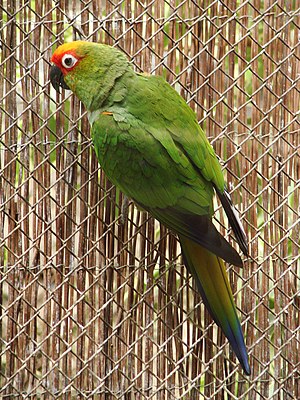Golden-parted parakeet
| Golden-parted parakeet | ||||||||||
|---|---|---|---|---|---|---|---|---|---|---|

Golden-parted parakeet ( Aratinga auricapilla ) |
||||||||||
| Systematics | ||||||||||
|
||||||||||
| Scientific name | ||||||||||
| Aratinga auricapilla | ||||||||||
| ( Kuhl , 1820) |
The golden-headed parakeet ( Aratinga auricapilla ) is a parrot species from the genus of the Macaws ( Aratinga ) that is endemic to Brazil .
description
The golden-headed parakeet has a body length of 30 cm, the tail length is 13-15 cm. The upper side is predominantly colored green. The chin and throat are yellowish-green and merge into a greenish-orange towards the upper part of the chest, the belly is red. On the forehead, the reins and around the eyes the color is bright red, the top of the head is yellow. The back feathers and the upper rump are edged in variable red or orange.
The large upper wing coverts, the arm wings and the outer flags and tips of the hand wings are blue, the lower wing coverts orange-red, the undersides of the wings gray. The lower tail-coverts of the golden-headed parakeet are green, the upper tail feathers brownish with a blue tip. Sometimes the outer flags of the outer tail feathers are blue. The lower control springs are gray.
Its beak is black and gray. He has gray, featherless dark circles, the iris is yellowish. The legs are grayish in color. Males and females are alike. The yellow of the top of the head of the young birds is paler than that of the adult animals. The red on the rump is less or missing. The breast is greener and has no orange tinge. The red area on the stomach is smaller.
distribution and habitat

The golden-headed parakeet is common in the mountainous region of southeastern Brazil . In the states of São Paulo and Paraná , the species is only found in the eastern rainforests, apparently no longer in Espírito Santo . In Rio de Janeiro and Santa Catarina it is very rare or extinct. It is still common locally in Goiás , Minas Gerais and Bahia .
The natural habitat of the golden-headed parakeet is the damp Atlantic coastal forest and transitional forests inland. It is largely dependent on semi-evergreen primary forests, foraging and breeding, but it also pursues forest edges, secondary forests, agricultural areas and even in cities. It occurs at heights of up to 2180 m.
Way of life
Golden- parted parakeets are gregarious animals and generally form groups of 12–20, rarely up to 40 birds. They feed on seeds and fruits, as well as crops like corn , okra and various sweet, soft fruits like mango , papaya and oranges . The species was considered an agricultural pest in some areas of Brazil before its populations fell sharply in these regions. Little is known about reproduction in the wild, the breeding season is believed to be November to December.
Danger
Habitat destruction and trapping for trade had severely affected this species, making it potentially endangered. In the red list of endangered species of the International Union for Conservation of Nature and Natural Resources (IUCN), the species is now on low endangered, early warning list (NT - Near Threatened) downgraded (2008), because the moderately small population in some areas due to the loss of habitat is declining, but the species seems to be coping relatively well with changes in its habitat.
The golden-headed parakeet is listed in the Washington Convention on the Protection of Species (CITES) in Appendix II and in EC Regulation 709/2010 [EC] in Appendix B and is particularly protected according to the Federal Nature Conservation Act [BG] (Status :: b).
Subspecies
There are two subspecies. Animals from southern Bahia mostly belong to transitional forms between the two subspecies.
- Aratinga auricapilla auricapilla (Kuhl, 1820) - North and Central Bahia . Nominate form .
- Aratinga auricapilla aurifrons Spix , 1824 , Golden- capped Parakeet - Southern Goiás and Minas Gerais as well as from Espírito Santo to Santa Catarina . The breast of this subspecies is greener, the orange hue of the nominate form is absent. The top is completely green, the red feather edges on the back and the upper rump are missing.
Individual evidence
- ↑ a b c d e f g h Tony Juniper, Mike Parr: Parrots: A Guide to Parrots of the World. Yale University Press, 1998, ISBN 978-0300074536 , pp. 447-448.
- ↑ a b c d Aratinga auricapillus in the IUCN Red List of Threatened Species 2011.1. Listed by: BirdLife International, 2008. Retrieved September 4, 2011.
- ↑ Federal Agency for Nature Conservation: WISIA-Online. accessed on January 1, 2012 Search online ( page no longer available , search in web archives ) Info: The link was automatically marked as defective. Please check the link according to the instructions and then remove this notice.
Web links
- Arthur Grosset's Birds , accessed December 12, 2009
- Bird Life International , accessed December 12, 2009
- World Parrot Trust , accessed February 15, 2010
- Parrots of Brazil , accessed January 1, 2012